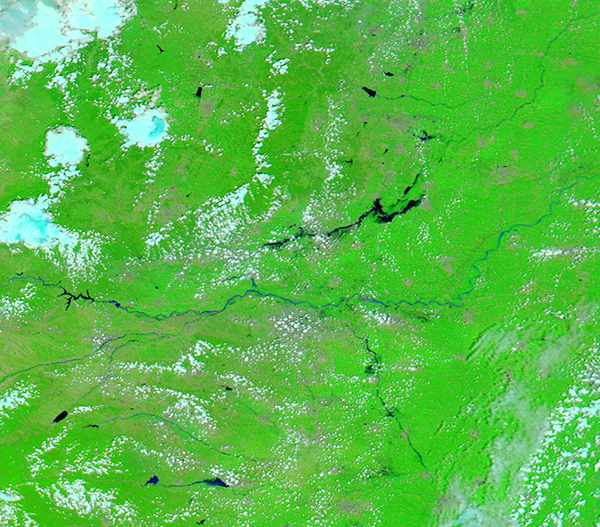Images
July 29, 2021 - Flooding in Central China
Tweet
A slow-moving rainstorm in mid-July 2021 caused rivers and reservoirs to spill over their banks, leading to deadly flooding in central China. A new storm has now come ashore, bringing even more rain to the country.
Flooding from the mid-July rainstorm was still visible on July 26, 2021, when the Moderate Resolution Imaging Spectroradiometer (MODIS) on NASA’s Aqua satellite acquired a false-color image of northern Henan province. In this type of image, vegetation appears bright green and water appears deep blue. to the NASA Worldview App, a comparison between the area on July 26, 2021, and July 20, 2020, can be seen HERE.
According to news reports, the rainstorm dropped a year’s worth of rain on Zhengzhou, the province’s capital city, over the span of three days. The storm then tracked north and dropped 26 centimeters (10 inches) of rain within a span of two hours on the city of Xinxiang. The region’s network of rivers and reservoirs overflowed, and floodwaters submerged transportation infrastructure and buildings, trapping many people and affecting millions.
Forecasters are now watching the progression of Tropical Cyclone In-fa. After lashing Japan, the Philippines, and Taiwan, Typhoon In-fa reached eastern China’s coast on July 25 with sustained winds equivalent to a Category-1 hurricane. Tens of thousands of people evacuated Shanghai ahead of the storm, which brought high winds and heavy rain.
According to the South China Morning Post, by July 27 meteorologists were blaming Typhoon In-Fa for abnormally intense rain to the region. They also reported the extreme flooding in Henan has left at least 71 people dead. Flash flooding also has been reported in Jiangsu Province on July 28, where the local meteorological observatory issued an orange warning signal (second strongest level) for the downpour resulting from the remnants of In-Fa.
Image Facts
Satellite:
Terra
Date Acquired: 7/26/2021
Resolutions:
1km (342.2 KB), 500m (908.4 KB), 250m (477.3 KB)
Bands Used: 1,4,3
Image Credit:
MODIS Land Rapid Response Team, NASA GSFC
Tweet
A slow-moving rainstorm in mid-July 2021 caused rivers and reservoirs to spill over their banks, leading to deadly flooding in central China. A new storm has now come ashore, bringing even more rain to the country. Flooding from the mid-July rainstorm was still visible on July 26, 2021, when the Moderate Resolution Imaging Spectroradiometer (MODIS) on NASA’s Aqua satellite acquired a false-color image of northern Henan province. In this type of image, vegetation appears bright green and water appears deep blue. to the NASA Worldview App, a comparison between the area on July 26, 2021, and July 20, 2020, can be seen HERE.
According to news reports, the rainstorm dropped a year’s worth of rain on Zhengzhou, the province’s capital city, over the span of three days. The storm then tracked north and dropped 26 centimeters (10 inches) of rain within a span of two hours on the city of Xinxiang. The region’s network of rivers and reservoirs overflowed, and floodwaters submerged transportation infrastructure and buildings, trapping many people and affecting millions.
Forecasters are now watching the progression of Tropical Cyclone In-fa. After lashing Japan, the Philippines, and Taiwan, Typhoon In-fa reached eastern China’s coast on July 25 with sustained winds equivalent to a Category-1 hurricane. Tens of thousands of people evacuated Shanghai ahead of the storm, which brought high winds and heavy rain.
According to the South China Morning Post, by July 27 meteorologists were blaming Typhoon In-Fa for abnormally intense rain to the region. They also reported the extreme flooding in Henan has left at least 71 people dead. Flash flooding also has been reported in Jiangsu Province on July 28, where the local meteorological observatory issued an orange warning signal (second strongest level) for the downpour resulting from the remnants of In-Fa.
Image Facts
Satellite:
Terra
Date Acquired: 7/26/2021
Resolutions:
1km (342.2 KB), 500m (908.4 KB), 250m (477.3 KB)
Bands Used: 1,4,3
Image Credit:
MODIS Land Rapid Response Team, NASA GSFC




